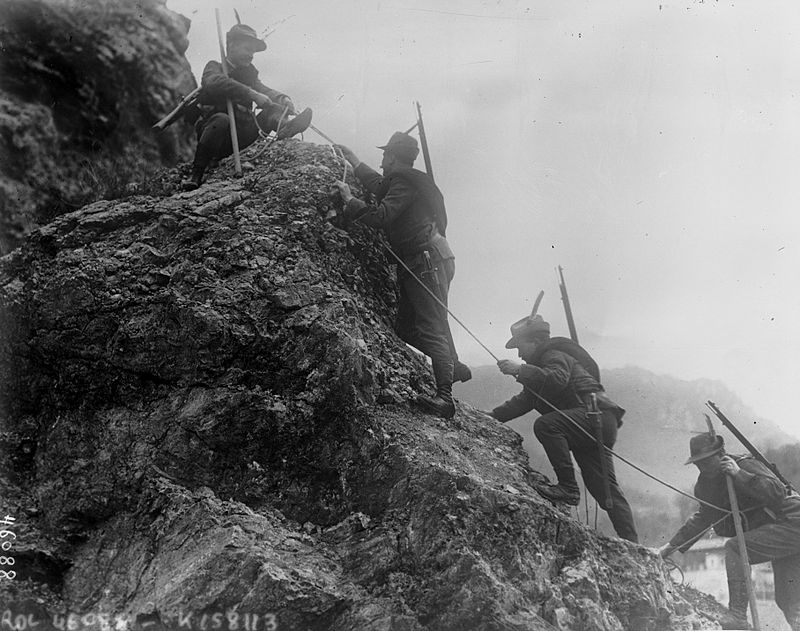World War I was a stage for many battles, big and small. Often overlooked or overshadowed by the more famous battles taught in the classroom, the fighting on the Italian Front proved to be very important for Italy’s reputation as a country and its inhabitants. It led to a significant loss of life, the absorption and reclamation of new territories, domestic unrest, and new alliances… for a while. Georgie Broad introduces World War One’s Italian Front.
Italy enters the war… But only just
In the years leading up to World War One, Italy had been allied with Germany and Austria-Hungary, a group more commonly and widely known as the “Triple Alliance”. Italy and Austria-Hungary had canonically be considered foes since 1832, and this tension showed in the August of 1914 when the Italian Government refused to enter the war alongside Austria-Hungary, and politicians began to consider the advantages of backing the Allies.
Many at the time, citizens and people in power alike, believed that Italy’s entering into the war at all was a bad move for the country. Even so, Italy as an entity was a relatively new nation state, becoming a unified country only after the Risorgimento in the nineteenth century, and as a result, it was eager to establish itself on the European political scene as a force to be reckoned with. This ambition was all very well and good, though compared to other European powers (especially the countries Italy would be fighting should it enter the war), Italy lacked major industry. Most of its economy remained agriculturally based. But most importantly, it lacked a competent military. Such was the indecision that two groups formed – the “neutralisti” (who wanted to stay out of the war and who formed a majority), and the “interventisti” (who wanted Italy to enter the war). After much debate, those who wanted to enter won the debate, helped by the backing of Prime Minister Antonio Salandra and Foreign Minister Sidney Sonnino. With the promise of territorial expansion and resources from Britain, on May 3, 1915, Italy ceased to be a part of the Triple Alliance, and 20 days later declared war on Austria-Germany.
Early battles on the Italian Front
Fighting along the Italian Front was comprised of several battles, many of which took place in the Isonzo region. As was widely suspected, the Italian Army proved to be militarily inexperienced, leading to Italian officers overcompensating for their lack of military prowess with risky and overly aggressive tactics. Despite the fact that the Austrians were heavily outnumbered, the early battles in the Isonzo region lasted over two years and caused a significant loss of Italian life. As unequal as the number of troops was, the armies eventually reached a stalemate and the battles bogged down to the most base trench warfare.
Meanwhile, on the home front…
This turn of events made the controversial Italian involvement in the war even more unpopular, causing the already angry neutralisti to start saying “I told you so”. This attitude started to spread to the wider Italian population from Pope Benedict XV to the poorer citizens living in the small, far-flung foothills of the country. While disapproval from the Pope was damning enough, it was in fact the unrest among the average citizen that caused more problems for the Italian war effort. Rumors of the lack of progress and high death rate began to spread around Italy, fuelling opposition in the population. It also led to the refusal of some to enlist and the rejection of conscription. Meanwhile, desertion in the army itself reached its highest ever level.
Such a high level of opposition eventually forced the awkward resignation of Italy’s Prime Minister and former avid supporter of Italy’s entry into the war, Antonio Salandra. Salandra was replaced by the ageing Paolo Boselli, which turned out to be a rather bittersweet progression. Boselli was the political equivalent of beige paint; he possessed no immediately obvious initiative, charisma, or talent – but he was a safe bet. He was not exactly the morale boost Italy needed, but any leader was better than no leader at all.

Later battles and victory
After the early battles that took place in the Isonzo region led to a stalemate, Italy’s bullish officers got tired of waiting and launched a counteroffensive in 1916, known as the Asiago Offensive. Alas for the Italians, this offensive resulted in no real gains.
However, the situation did improve with time. Later in 1916, fighting continued in the Isonzo, and eventually, the Italians captured the town of Gorizia. This was exactly the shot of morale that the Italian Army so desperately needed. From then on, victory for the Italians seemed a more realistic prospect, and in 1918, two vital battles occurred that secured the Italians victory for good. The Battle of the Piave River left Austrian troops in dire need of supplies and Italian troops in grave need of reinforcements (which eventually came from Britain, France, and the USA). After Italy received reinforcements, Armando Diaz – an Italian general – launched an offensive over the River Piave on Vittorio Veneto. This attack crushed the Austrian defensive line, resulting in an eventual truce flag being sent to Italian commanders on November 3, 1918, along with Austrian requests for peace terms. It was accepted, and fighting along the Italian front ceased.
Did you find this article interesting? If so, tell the world. Tweet about it, share it, or like it by clicking on one of the buttons below!
